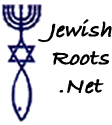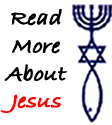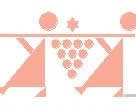






![]()
Tu B'Shvat is considered a joyous holiday. Some have included as part of the holidays celebration, what has become known as a Tu B'Shvat seder. This seder (meal) contains specific food to remind us of certain things, similar in some ways to a Passover seder meal.
 The grapevine is like a human community. The leaves are like
the amei ha'artzot, the people of the land, who work the land and provide food
for all, as the leaves sustain the plant through photosynthesis. The branches,
which distribute what the leaves produce to the entire plant, are like the
merchants who distribute goods to the entire community. The tendrils, which
fasten the grapevine to its support, are like those who produce neither goods
nor scholarship, but have a function in the community. The bunches of grapes are
like the scholars, who cannot survive without all the other parts of the
grapevine/community. (Babylonian Talmud, Hulin 92b)
The grapevine is like a human community. The leaves are like
the amei ha'artzot, the people of the land, who work the land and provide food
for all, as the leaves sustain the plant through photosynthesis. The branches,
which distribute what the leaves produce to the entire plant, are like the
merchants who distribute goods to the entire community. The tendrils, which
fasten the grapevine to its support, are like those who produce neither goods
nor scholarship, but have a function in the community. The bunches of grapes are
like the scholars, who cannot survive without all the other parts of the
grapevine/community. (Babylonian Talmud, Hulin 92b)
Why is the Torah compared to the fig?
1) Unusual among fruit trees, the fig can produce fruit over a long season, from Shavuot to Sukkot (late May to early October).
a) You cannot pick all the figs at once, but only gradually, over a long season. Similarly, you cannot learn the whole Torah at once, but only gradually, little by little, over an entire lifetime. (Midrash Numbers Rabba 12,9; 21,15)
b) Whenever you go to the fig tree, you are likely to find ripe fruit to eat. Similarly, whenever you go to the Torah, you will find nourishment for the spirit. (Babylonian Talmud, Eruvin 54a, b)
2) Most fruits have inedible parts: dates have pits, grapes have seeds, pomegranates have skins. But every part of the fig can be eaten. Similarly, no part of the Torah is without value; all parts of it provide sustenance. (Midrash Yalkut Shimoni, Joshua 2)
Dates grow in desert oases, such as Jericho, which was famous for its date palms. This midrash hinges on the Jericho date palms.
Just before Moses' death, he was shown the Promised Land that he would never enter. "Moses went up from the steppes of Moav to Mount Nevo, to the summit of Pisgah, facing Jericho, and the Lord showed him the whole land...as far as the Western Sea, the Negev, and the plain, the valley of Jericho, city of date palms...saying, this the land that I have let you see with your own eyes, but you shall not cross there" (Deuteronomy 34:1-4).
The midrash says that Moses, at this final moment before his death, was shown the Garden of Eden and the righteous walking there, through the date palms of Jericho: As Psalm 92 says: "The righteous shall flourish like the date palm tree... " (Psalm 92:13). (Yalkut Shimoni)
No part of the date palm is wasted: The fruit is eaten, the embryonic branches (lulav) are used for the Four Species of Sukkot, the mature fronds can cover a sukkah, the fibers between the branches can make strong ropes, the leaves can be woven into mats and baskets, the trunks can be used for rafters. Similarly, no one is worthless in Israel: some are scholars, some do good deeds, and some work for social justice. (Midrash Numbers Rabba 3.1)
If you remove one nut from a pile of walnuts, every nut in the pile will be shaken. Similarly, if one person sins, the whole community will suffer. (Midrash Song of Songs Rabba 1 on 6:11).
The almond, which needs little water, is the first fruit tree in Israel to wake from its winter dormancy, and bursts into bloom when the others are still bare and "asleep." The Hebrew name for almond is thus "shaked", meaning watchful, wakeful, diligent, or alert.
The almond often appears symbolically in the Bible:
"The Lord asked me: Jeremiah, what do you see?
I answered: I see a branch of an almond tree (shaked).
The Lord said to me: You have seen right, For I am watchful (shoked) to bring My
word to pass" (Jeremiah 1:11-12).
People and Land:
"The land must not be sold in perpetuity, for the land is Mine; you are but sojourners resident with me" (Leviticus 25:23).
Two people were once fighting over a piece of land. Each claimed ownership, and each bolstered the claim with apparent proof. After arguing for a long time, they agreed to resolve their conflict by putting the case before a rabbi. The rabbi sat as an arbitrator and listened carefully, but despite years of legal training the rabbi could not reach a decision. Both parties seemed to be right.
Finally the rabbi said, "Since I cannot decide to whom this land belongs, let's ask the land." The rabbi put an ear to the ground, and after a moment stood up. "My friends, the land says it belongs to neither of you but that you belong to it." (Source unknown, cited by Rabbi David E. Stein in A Garden of Choice Fruits, Shomrei Adamah, 1991).
"No shrub of the field was yet on earth and no grasses of the field had yet sprouted, for the Lord God had not yet sent rain upon the earth, and there were no humans to till the soil" (Genesis 2:5).
The earth, the rain, and human beings are all equal in importance. Each word has three letters in Hebrew : earth (eretz), rain (matar), humans (adam). Without the earth, there is no rain; without the rain, the earth cannot endure; and without both the earth and the rain, humans cannot live. (Midrash Genesis Rabba 13, 3).
In the New Testament Jesus compares Israel to a Fig Tree.
Read about The Holiday Of Tu B'shvat.
Articles of interest include:
This information was used with permission from About Judaism (http://judaism.about.com).